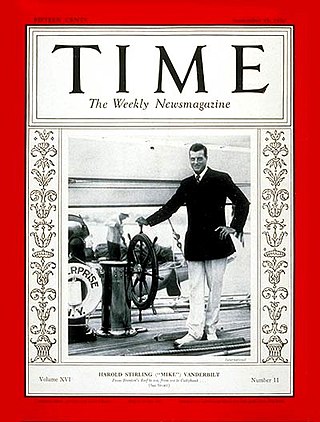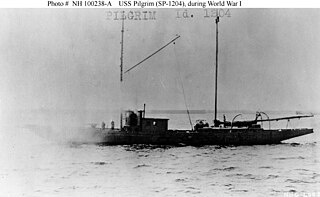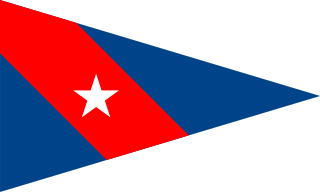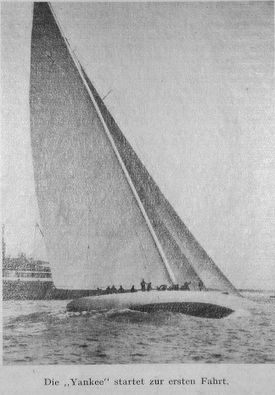
The America's Cup, informally known as the Auld Mug, is a trophy awarded in the sport of sailing. It is the oldest international competition still operating in any sport. America's Cup match races are held between two sailing yachts: one from the yacht club that currently holds the trophy and the other from the yacht club that is challenging for the cup. Matches are held several years apart on dates agreed between the defender and the challenger. There is no fixed schedule, but the races have generally been held every three to four years. The most recent America's Cup match took place in March 2021.

Marblehead is a coastal New England town in Essex County, Massachusetts, along the North Shore. Its population was 20,441 at the 2020 census. The town lies on a small peninsula that extends into the northern part of Massachusetts Bay. Attached to the town is a near island, known as Marblehead Neck, connected to the mainland by a narrow isthmus. Marblehead Harbor, protected by shallow shoals and rocks from the open sea, lies between the mainland and the Neck. Beside the Marblehead town center, two other villages lie within the town: the Old Town, which was the original town center, and Clifton, which lies along the border with the neighboring town of Swampscott.

Harold Stirling Vanderbilt CBE was an American railroad executive, a champion yachtsman, an innovator and champion player of contract bridge, and a member of the Vanderbilt family.

The Marblehead to Halifax Ocean Race (MHOR) is a biennial sailing race which celebrated its 100th anniversary in 2005. It runs between Marblehead, Massachusetts and Halifax, Nova Scotia. It is believed to be the longest running offshore ocean race in the world and is considered one of the pre-eminent ocean races of the North Atlantic.

Ranger was a J-class racing yacht that successfully defended the 1937 America's Cup, defeating the British challenger Endeavour II 4-0 at Newport, Rhode Island. It was the last time J-class yachts would race for the America's Cup.

A J-Class yacht is a single-masted racing yacht built to the specifications of Nathanael Herreshoff's Universal Rule. The J-Class are considered the peak racers of the era when the Universal Rule determined eligibility in the America's Cup.

Reliance was the 1903 America's Cup defender designed by Nat Herreshoff.

Galatea was the unsuccessful Scottish challenger of the sixth America's Cup race in 1886 against American defender Mayflower.

His Majesty's Yacht Britannia was a gaff-rigged cutter built in 1893 for RYS Commodore Albert Edward, Prince of Wales. She served both himself and his son King George V with a long racing career.

William Starling Burgess was an American yacht designer, aviation pioneer, and naval architect. He was awarded the highest prize in aviation, the Collier Trophy in 1915, just two years after Orville Wright won it. In 1933 he partnered with Buckminster Fuller to design and build the radical Dymaxion Car. Between 1930 and 1937 he created three America's Cup winning J-Class yachts, Enterprise, Rainbow and Ranger.

The third USS Pilgrim (SP-1204) was a United States Navy patrol vessel in commission from 1917 to 1919.

Shamrock V was the first British yacht to be built to the new J-Class rule. She was commissioned by Sir Thomas Lipton for his fifth America's Cup challenge. Although refitted several times, Shamrock is the only original J-class never to have fallen into dereliction.

The Montgomery-class cruisers were three unprotected cruisers built for the United States Navy in the early 1890s. They had a thin water-tight protective deck, and also relied for protection upon their coal bunkers, cellulose packing, and numerous compartments. Roomy accommodations were provided for officers and crew, these cruisers being mainly intended for long cruises on distant stations.
Enterprise was a 1930 yacht of the J Class and successful defender of the 1930 America's Cup for the New York Yacht Club. It was ordered by a syndicate headed by Vice-Commodore Winthrop Aldrich, designed by Starling Burgess, and built by Herreshoff Manufacturing Company.
Whirlwind was a 1930 yacht of the J Class built as a contender for the New York Yacht Club's defence of the 1930 America's Cup. She was ordered by a syndicate headed by Landon Ketchum Thorne, designed by Lewis Francis Herreshoff, and built by Lawley & Son. Whirlwind was unsuccessful in her bid to become the Cup defender, an honor that went to Enterprise. She never sailed again after the Cup races, and was scrapped in 1935.
Weetamoe was a 1930 yacht of the J Class built as a contender for the New York Yacht Club's defence of the 1930 America's Cup. She was ordered by a syndicate headed by Junius Morgan, designed by Clinton Hoadley Crane, and built by Herreshoff Manufacturing Company. Weetamoe was unsuccessful in her bid to become the Cup defender, an honor that went to Enterprise. She continued to sail for a few years afterwards, before being scrapped in 1937.

Constellation was the largest steel schooner when completed, having been designed by the yacht designer Edward Burgess and launched in 1889. She was built at the Piepgras Shipyard on City Island in the Town of Pelham on Long Island, New York. It was built for yachtsman Edwin D. Morgan III, who was a commodore of the New York Yacht Club, and grandson of New York Governor and state senator Edwin D. Morgan. The vessel remained in service on the United States East Coast at Marblehead, Massachusetts, until 1941 when the schooner was taken out of service and scrapped for its metal to aid the war effort.

The Eastern Yacht Club is located in Marblehead, Massachusetts and founded in 1870. It is one of the oldest yacht clubs on the east coast with significant involvement in the history of American yachting.

Herbert Mason Sears was a noted yachtsman and businessman in Boston, Massachusetts. He was awarded the Croix de Guerre for his contributions during World War I.
The 1930 America's Cup was the 14th challenge for the Cup. It took place in Newport and consisted of a series of races between the defender Enterprise, entered by a syndicate of New York Yacht Club members headed by Winthrop Aldrich, and Shamrock V, the fifth in Sir Thomas Lipton's line of Cup challengers. Harold S. Vanderbilt was the skipper of Enterprise in this race.
















